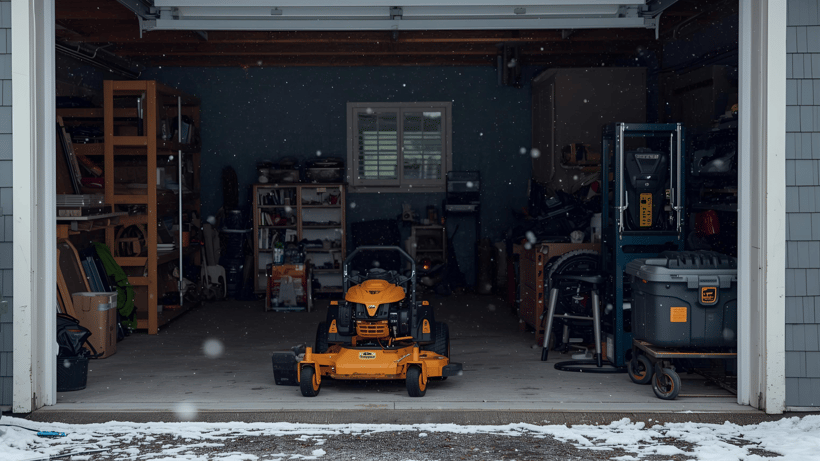
Properly storing and winterizing lawn equipment protects engines, prevents corrosion, and ensures smooth start-up in spring.
When the final mowing of the season is done, it’s tempting to park your equipment and forget about it until spring. But skipping winterization is one of the fastest ways to shorten the life of your mowers, trimmers, and small engines—and create costly, frustrating repairs down the road.
Winterizing your lawn equipment is one of the most cost-effective maintenance tasks you can perform. A few hours of preparation now saves hundreds later and ensures everything starts reliably as soon as the weather warms up.
Why Skipping Winterization Gets Expensive
The biggest threats to stored lawn equipment aren’t cold temperatures—they’re fuel breakdown, moisture, and neglected components.
Fuel Deterioration
Gasoline begins to degrade in as little as 30 days. As it breaks down, it leaves behind sticky varnish that clogs:
-
Carburetor jets
-
Fuel filters
-
Fuel lines
This is the #1 reason equipment won’t start in the spring.
Moisture & Corrosion
Temperature swings create condensation inside:
-
Fuel tanks
-
Oil reservoirs
-
Cylinders
This moisture causes rust, corrosion, and premature engine wear.
Dirty Oil & Debris
Old oil turns acidic and loses lubricating power. And grass buildup—especially under mower decks—creates rust pockets that spread into critical areas.
Essential Steps for Proper Winterization
1. Clean & Inspect Thoroughly
Start with a deep clean:
-
Disconnect the spark plug.
-
Wash away grass and debris (especially under the deck).
-
Scrape off stuck-on grass with a putty knife.
-
Let everything dry fully.
This is also the perfect time to tighten bolts, check for wear, and note anything that should be repaired before next season.
2. Protect the Fuel System
You have two options:
✅ Option A: Treat the Fuel
Add stabilizer to a nearly full tank, then run the engine for ~10 minutes so treated fuel circulates through the entire system.
✅ Option B: Drain the System
Empty the tank completely and run the engine dry. This eliminates fuel breakdown risks but requires proper fuel disposal.
3. Change the Oil & Filter
Always change oil before storing equipment—not after winter. Used oil contains acids that damage internal parts.
Steps:
-
Warm the engine briefly.
-
Drain old oil completely.
-
Replace the oil filter.
-
Refill with clean oil (per manufacturer specs).
4. Replace Spark Plug & Air Filter
-
Install a new spark plug.
-
Hand-tighten, then give a light quarter-turn with a wrench.
-
Disconnect the plug wire until spring.
-
Replace the air filter if it’s dirty or damaged.
5. Protect Internal Components
-
Apply fogging oil to the air intake to coat cylinder walls and prevent corrosion.
-
Grease all fittings and moving parts.
6. Care for the Battery (Electric Start Equipment)
-
Disconnect negative terminal first, then positive.
-
Clean corrosion with baking soda and a brush.
-
Store batteries in a dry, above-freezing location.
-
Use a trickle charger for long-term health.
7. Sharpen & Inspect Blades
-
Remove mower blades.
-
Have them sharpened professionally or sharpen at home if experienced.
-
Replace any cracked or worn blades now—not in spring when demand spikes.
Winterization Tips by Equipment Type
Electric Equipment
-
Remove and store batteries in a climate-controlled area.
-
Charge periodically throughout winter.
-
Clean and lubricate per manufacturer instructions.
Two-Stroke Equipment (Trimmers, Blowers, Chainsaws)
-
Drain all fuel or use stabilizer formulated for two-stroke engines.
-
Run the engine dry to clear the carburetor.
Riding Mowers & Zero-Turns
-
Check tire pressure.
-
Lubricate all fittings.
-
Clean the deck thoroughly.
-
Inspect belts and replace worn ones.
DIY vs. Professional Winterization
| Option | Cost | Time | Best For |
|---|---|---|---|
| DIY | $30–$40 in supplies | 2–4 hours (gas), 1 hour (electric) | Homeowners with basic tools |
| Professional | $100–$200 | — | Multiple machines, limited time, or desire for full inspection |
Professional service often includes adjustments, multi-point inspections, and work warranties—ideal for commercial equipment.
Storage Best Practices
-
Choose a clean, dry location.
-
Use breathable covers (avoid plastic).
-
Elevate equipment off concrete floors if possible.
-
Store batteries indoors.
-
Ensure ventilation around stored fuel.
Proper storage adds months—sometimes years—to equipment life.
Final Thoughts
Winterizing lawn equipment is one of the smartest, simplest ways to protect your investment. A small amount of time now pays off with:
✅ Easier spring start-up
✅ Fewer repairs
✅ Longer equipment lifespan
✅ Better performance all season long
If you manage commercial properties and want help winterizing equipment—or you’re considering outsourcing grounds maintenance altogether—our team can ensure your property is protected year-round.
